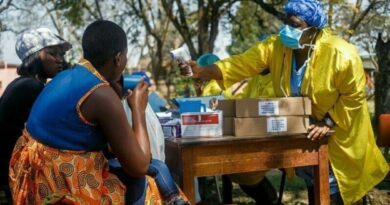No one is immune to skin cancer: A simple mole can be dangerous
Melanoma can develop anywhere on the body, in otherwise normal skin or in an existing mole that becomes cancerous.
By Rumbidzai Zinyuke
WhatsApp has become one of our go-to places to ask for advice about anything from recipes, do-it-yourself tips, even home remedies for our minor health issues.
It is, of course the cheapest and easiest way to get such tips because everyone is on the platform, so whatever question you ask, you will definitely get a response from someone. Good or bad.
So without visiting a doctor, one can ask ‘friends’ in their WhatsApp group what could be causing the symptoms they are experiencing.
And our good friends will have something to say.
I remember a lady in one of the numerous WhatsApp groups that I am in asking about a mole on her child’s shoulder sometime last year. She said the mole had appeared when the boy was still small and it had been growing slowly as the child also grew.
The mole was not painful so she was just concerned about what this could be and what she could use to remove it.
Of course the WhatsApp doctors had a lot of advice.
One said “These are very common if it’s not painful then don’t worry about it.”
Another one told the mother “I have had one of these my whole life it’s not anything to worry about, just let it be.”
The other pieces of advice ranged from applying a banana peel on the mole for it would go away, to applying different natural herbs.
A few of her ‘friends’ told her to visit the doctor and get a proper diagnosis for the child so that she could get the correct treatment.
Unfortunately, the mother did not have money to visit a doctor or the clinic so she said she had to be content with the advice she got from other parents in various groups on the WhatsApp platform.
I remember thinking what if this mole was dangerous? But there was nothing much I, or anyone else could do to force the mother to go to the clinic.
I still have no idea what became of that mole on the boy’s shoulder, but I know many other Zimbabweans could have similar moles which they have ignored simply because it does not hurt or has been there all their life.
If it does not hurt, then it is nothing to worry about, they say.
Rarely do we ever think it could be a form of cancer.
But skin cancer is there and it is affecting hundreds of people in the country and beyond.
While the numbers are lower than most of the cancers we have been wired to be on the lookout for, it is still a cancer of concern for Zimbabwe, Africa and indeed the whole world.
Skin cancer is the abnormal growth of skin cells, which most often develops on skin exposed to the sun but can also occur on areas of the skin not ordinarily exposed to sunlight.
There are two main types of skin cancer, which are melanoma and non-melanoma.
Skin cancer affects people of all skin tones, including those with darker complexions. When melanoma occurs in people with dark skin tones, it is more likely to occur in areas not normally exposed to the sun, such as the palms of the hands and soles of the feet.
According to the World Cancer Research Fund melanoma skin cancer is the 17th most common cancer worldwide. There were more than 150 000 new cases of melanoma of skin in 2020.
However, non-melanoma skin cancer is often excluded from the reporting of cancer statistics and is not reported in global total cancer cases.
This is because it is common, often under-diagnosed, and commonly treated within primary care and therefore likely to be under-reported in national cancer registry data.
But if untreated, skin cancer can lead to death.
Zimbabwe is among the 10 countries which recorded the highest number of deaths from both types of skin cancer in 2020.
Although African countries did not report high number of cases as was the case for the Americas, Europe and Asia, mortality rates remain much higher on the continent compared to other regions.
Papua New Guinea had the highest rate of non-melanoma skin cancer mortality in 2020, followed by Namibia. Zimbabwe was ranked fourth on that list of countries with the highest mortality rates with regards non-melanoma cancers.
Local statistics from the National Cancer Registry annual report of 2018 show that melanoma skin cancer was among the most common type of cancer among non-black men, accounting for 4,6 percent of all cancers reported for this group while also accounting for 6,2 percent of cancers among non-black Zimbabwean women.
Kaposi sarcoma, a rare type of skin cancer, was the sixth most common cancer in Zimbabwe after cervical, prostate, breast, non-Hodgkin lymphoma and oesophagus cancers. It accounted for four percent of the total number of cases reported during that year.
This type of cancer was more common among black men, being reported as the third leading form of cancer accounting for 7,2 percent of cases while among black women, it accounted for 2,2 percent of cancers detected in 2018.
Kaposi’s sarcoma is a rare form of skin cancer that develops in the skin’s blood vessels and causes red or purple patches on the skin or mucous membranes.
Kaposi sarcoma mainly occurs in people with weakened immune systems, such as people with AIDS, and in people taking medications that suppress their natural immunity.
With such high mortality rates, skin cancers should be on our radar.
We should be speaking about them and encouraging the people to seek medical advice in cases where they do not understand what is going on in their bodies.
For people to understand skin cancer, below are a few facts that will help them to understand what it is and how it affects them.
The most important thing to understand is that melanoma can develop anywhere on the body, in otherwise normal skin or in an existing mole that becomes cancerous.
Symptoms can include a large brownish spot with darker speckles, a mole that changes in colour, size or feel or that bleeds, a small lesion with an irregular border and portions that appear red, pink, white, blue or blue-black, a painful abrasion that itches or burns or dark lacerations on the palms, soles, fingertips or toes, or on mucous membranes lining the mouth, nose and private parts.
Experts say the main cause of skin cancer is overexposure to sunlight, especially when one has sunburn and blistering.
UV rays from the sun damage DNA in the skin, causing abnormal cells to form.
These abnormal cells rapidly divide in a disorganised way, forming a mass of cancer cells.
Risk factors for skin cancer among others include fair skin, a history of sunburns, excessive sun exposure, sunny or high-altitude climates and moles.
People who have many moles or abnormal moles are at increased risk of skin cancer.
These abnormal moles, which look irregular and are generally larger than normal moles, are more likely than others to become cancerous.
Other risks include a family history of skin cancer, a weakened immune system, exposure to radiation and exposure to certain substances such as arsenic.
As with all other types of cancer, prevention is the best medicine.
With skin cancer, avoiding the sun during the middle of the day, wearing sunscreen, wearing protective clothing and regularly checking the skin for any changes in size, shape or colour of skin growths or the development of new skin spots.
No one is immune to skin cancer.
Anyone can get it, regardless of race or sex.
Unfortunately, skin cancer is often diagnosed in later stages for people with darker skin tones making it more difficult to treat. But if it is identified and treated in early stages, most are cured.
It is therefore essential to educate all people, regardless of ethnicity, on sun protection, skin cancer prevention, risk factors and warning signs.
Encouraging whole-body examinations and sun protection in people of any skin colour is also of paramount importance when it comes to facilitating early detection.




